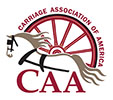
Dogs and horses go together like peanut butter and jelly so it should come as no surprise that there is such a thing as Dog Carts and Dog Cart Phaetons in the carriage driving world. William Felton’s A Treatise on Carriages, written in 1796, mentions Shooting Phaetons, used by hunting parties, with room for dogs. Shooting Phaetons evolved into what we now call Dog Cart Phaetons. These phaetons had four wheels, were usually cut-under (meaning the floor under the front seat is raised so that the front wheels can move partly under the vehicle when turning), and have louves or slats along the sides of the vehicle to allow for ventilation in the dog area (under the seat). They also have a trap door in the back that allows the dog to be put in the space under the seat. They were a popular vehicle in England until taxes came into play.

In 1843 there was an English tax exemption made for “all two-wheeled carriages not costing more that 21 pounds, from the assessed tax, provided the name of the owner was painted in letters, not less than four inches in length on a conspicuous part of the vehicle.” (Carriage Terminology by Berkebile) As a result two wheeled vehicles like the Dog Cart became extremely popular. The bill would read, 20 pounds, 19 shillings (or something similar) to satisfy the tax and then there would be a separate bill for the “extras” like lamps, seat cushions, etc, that would run another five or ten pounds. Clever! According to Berkebile, at one point the Dog Carts were so popular that the expression, “I will send the Dog Cart to meet you” was a common postscript on letters.


The concept of a Dog Cart can be a bit confusing if you’re familiar with the Carriage Dog Classes that take place at modern carriage shows. Today, dogs often sit next to their owner on the seat (sometimes in a basket) and may even wear funny hats. Or you may be familiar with the idea of a coaching dog, where the dog runs along side the coach. These dogs would scare off robbers and highway men, having been trained to run off unfamiliar horses. (Learn more by reading Dogs That Earn Their Living by Cornish) The dogs that rode in Dog Carts and Dog Cart Phaetons were primarily hunting or sporting type dogs. As a result they need to be rested when they arrived at the hunt and also needed to be contained so they didn’t follow their nose at the wrong time.

Unsurprisingly Dog Carts are typically one-horse vehicles, they are considered excellent tandem carts. Tandem is where two horses are driven, one in front of the other. In many cases horses were driven tandem to hunts – the front horse, either in harness or a hybrid of harness and saddle, would do very little work. Upon arriving at the hunt the wheeler (horse closest to the carriage) would have been allowed to rest. The front horse, who was still fresh and the dog, who was rested from riding in the cart, would be put to work in the hunt. At the end of the day the dog would be put in the cart, the hunt horse put back into the front position of the tandem and the wheeler, who had been resting, would do the majority of the work as the group headed for home.

Dog Carts and Dog Cart Phaetons are “classed as “sporting carriages,” and the use of bright colors for them is quite acceptable.” (The Dog-cart Phaeton and the American Trap Turnout Guide) Yellow, blue, green and red are often seen on the wheels, springs and louvers. The actual body of the vehicle is typically black. Sometimes the vehicles are left with a natural wood finish. Unfortunately, in the United States the yellowish wood of the American poplar was often used to make the carriage panels, rendering the wood unsuitable for natural finish.
As a sporting vehicle these carriages would have been considered a gentlemen’s vehicle. The exception is the Alexandra Dog Cart, which is considered a lady’s vehicle. Information on Alexandra Dog Carts is a bit scarce but the carts themselves are a bit easier to find. They have the same body as a regular Dog Cart but lack the louves or slats on the sides that would typically mark a vehicle as a Dog Cart. The DeVries Nature Conservancy in Owosso, Michigan has one on display as part of the DeVries Carriage Collection.

Written by Kathleen Haak for the Carriage Association of America
Resources:
A Treatise on Carriages by William Felton
Carriage Terminology by Don Berkebile
The Dog-cart Phaeton and the American Trap Turnout Guide edited by Tom Rider
Dogs That Earn Their Living by Cornish
The Hub, May 1892
